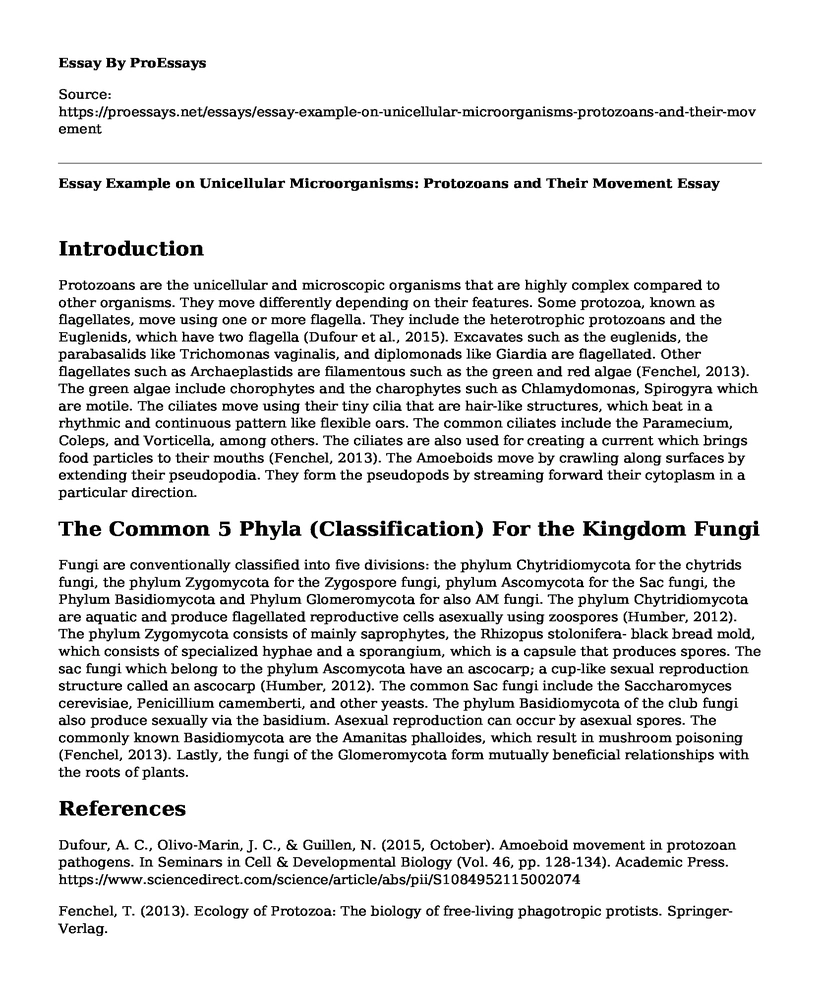Introduction
Protozoans are the unicellular and microscopic organisms that are highly complex compared to other organisms. They move differently depending on their features. Some protozoa, known as flagellates, move using one or more flagella. They include the heterotrophic protozoans and the Euglenids, which have two flagella (Dufour et al., 2015). Excavates such as the euglenids, the parabasalids like Trichomonas vaginalis, and diplomonads like Giardia are flagellated. Other flagellates such as Archaeplastids are filamentous such as the green and red algae (Fenchel, 2013). The green algae include chorophytes and the charophytes such as Chlamydomonas, Spirogyra which are motile. The ciliates move using their tiny cilia that are hair-like structures, which beat in a rhythmic and continuous pattern like flexible oars. The common ciliates include the Paramecium, Coleps, and Vorticella, among others. The ciliates are also used for creating a current which brings food particles to their mouths (Fenchel, 2013). The Amoeboids move by crawling along surfaces by extending their pseudopodia. They form the pseudopods by streaming forward their cytoplasm in a particular direction.
The Common 5 Phyla (Classification) For the Kingdom Fungi
Fungi are conventionally classified into five divisions: the phylum Chytridiomycota for the chytrids fungi, the phylum Zygomycota for the Zygospore fungi, phylum Ascomycota for the Sac fungi, the Phylum Basidiomycota and Phylum Glomeromycota for also AM fungi. The phylum Chytridiomycota are aquatic and produce flagellated reproductive cells asexually using zoospores (Humber, 2012). The phylum Zygomycota consists of mainly saprophytes, the Rhizopus stolonifera- black bread mold, which consists of specialized hyphae and a sporangium, which is a capsule that produces spores. The sac fungi which belong to the phylum Ascomycota have an ascocarp; a cup-like sexual reproduction structure called an ascocarp (Humber, 2012). The common Sac fungi include the Saccharomyces cerevisiae, Penicillium camemberti, and other yeasts. The phylum Basidiomycota of the club fungi also produce sexually via the basidium. Asexual reproduction can occur by asexual spores. The commonly known Basidiomycota are the Amanitas phalloides, which result in mushroom poisoning (Fenchel, 2013). Lastly, the fungi of the Glomeromycota form mutually beneficial relationships with the roots of plants.
References
Dufour, A. C., Olivo-Marin, J. C., & Guillen, N. (2015, October). Amoeboid movement in protozoan pathogens. In Seminars in Cell & Developmental Biology (Vol. 46, pp. 128-134). Academic Press. https://www.sciencedirect.com/science/article/abs/pii/S1084952115002074
Fenchel, T. (2013). Ecology of Protozoa: The biology of free-living phagotropic protists. Springer-Verlag. https://books.google.co.ke/books?hl=en&lr=&id=bfLSBgAAQBAJ&oi=fnd&pg=PR5&dq=how+protozoa+moves
Humber, R. A. (2012). Entomophthoromycota: a new phylum and reclassification for entomophthoroid fungi. Mycotaxon, 120(1), 477-492. https://www.ingentaconnect.com/contentone/mtax/mt/2012/00000120/00000001/art00058
Cite this page
Essay Example on Unicellular Microorganisms: Protozoans and Their Movement. (2023, Sep 07). Retrieved from https://proessays.net/essays/essay-example-on-unicellular-microorganisms-protozoans-and-their-movement
If you are the original author of this essay and no longer wish to have it published on the ProEssays website, please click below to request its removal:
- Malaysia Area History and Customs Essay
- Linear Transformation and Road Function Paper Example
- Nature of Magnetic Surfactants Essay Example
- Research Paper on Extinction & Endangered Species: A Human-Catalyzed Catastrophe
- Proofs and Disproof's of the Big Bang Theory Essay
- Paper Example on 500,000 Years of Bird Evolution: Mutations & Adaptations
- Essay Example on Linus Pauling: Nobel Laureate Who Changed Lives







